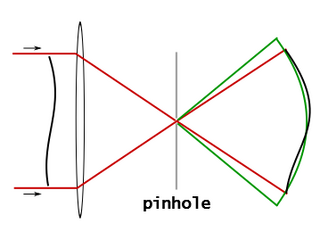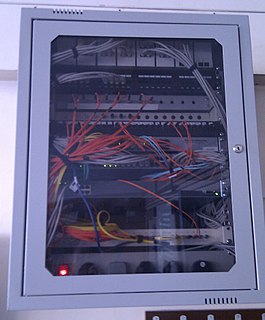In electronics and telecommunications, modulation is the process of varying one or more properties of a periodic waveform, called the carrier signal, with a modulating signal that typically contains information to be transmitted. Most radio systems in the 20th century used frequency modulation (FM) or amplitude modulation (AM) for radio broadcast.
Quadrature amplitude modulation (QAM) is the name of a family of digital modulation methods and a related family of analog modulation methods widely used in modern telecommunications to transmit information. It conveys two analog message signals, or two digital bit streams, by changing (modulating) the amplitudes of two carrier waves, using the amplitude-shift keying (ASK) digital modulation scheme or amplitude modulation (AM) analog modulation scheme. The two carrier waves of the same frequency are out of phase with each other by 90°, a condition known as orthogonality and as quadrature. Being the same frequency, the modulated carriers add together, but can be coherently separated (demodulated) because of their orthogonality property. Another key property is that the modulations are low-frequency/low-bandwidth waveforms compared to the carrier frequency, which is known as the narrowband assumption.
An optical switch is a device that enables optical signals to be selectively switched-on and -off or switched from one channel to another. The former is known as an optical (time-domain) switch or an optical modulator, while the latter can be specifically called an optical space switch or an optical router. In its ways to be switched temporally or spatially, it can be seen as physical analogies to the one-way or two-way switches in electrical circuits. In general, optical modulators and routers can be made from each other.
Phase-shift keying (PSK) is a digital modulation process which conveys data by changing (modulating) the phase of a constant frequency reference signal. The modulation is accomplished by varying the sine and cosine inputs at a precise time. It is widely used for wireless LANs, RFID and Bluetooth communication.

In fiber-optic communications, wavelength-division multiplexing (WDM) is a technology which multiplexes a number of optical carrier signals onto a single optical fiber by using different wavelengths of laser light. This technique enables bidirectional communications over one strand of fiber, as well as multiplication of capacity.

Interferometry is a family of techniques in which waves, usually electromagnetic waves, are superimposed, causing the phenomenon of interference, which is used to extract information. Interferometry is an important investigative technique in the fields of astronomy, fiber optics, engineering metrology, optical metrology, oceanography, seismology, spectroscopy, quantum mechanics, nuclear and particle physics, plasma physics, remote sensing, biomolecular interactions, surface profiling, microfluidics, mechanical stress/strain measurement, velocimetry, and optometry.

In physics, the Mach–Zehnder interferometer is a device used to determine the relative phase shift variations between two collimated beams derived by splitting light from a single source. The interferometer has been used, among other things, to measure phase shifts between the two beams caused by a sample or a change in length of one of the paths. The apparatus is named after the physicists Ludwig Mach and Ludwig Zehnder: Zehnder's proposal in an 1891 article was refined by Mach in an 1892 article.
DLI is a three-letter abbreviation that may refer to:
Four-wave mixing (FWM) is an intermodulation phenomenon in non-linear optics, whereby interactions between two or three wavelengths produce two or one new wavelengths. It is similar to the third-order intercept point in electrical systems. Four-wave mixing can be compared to the intermodulation distortion in standard electrical systems. It is a parametric nonlinear process, in that the energy of the incoming photons is conserved. FWM is a phase-sensitive process, in that the efficiency of the process is strongly affected by phase matching conditions.
A passive optical network (PON) is a telecommunications technology used to provide fiber to the end consumer, both domestic and commercial. A PON's distinguishing feature is that it implements a point-to-multipoint architecture, in which unpowered fiber optic splitters are used to enable a single optical fiber to serve multiple end-points. The end-points are often individual customers, rather than commercial. A PON does not have to provision individual fibers between the hub and customer. Passive optical networks are often referred to as the "last mile" between an ISP and customer.
Optical networking is a means of communication that uses signals encoded onto light to transmit information among various nodes of a telecommunications network. They operate from the limited range of a local-area network (LAN) or over a wide-area network (WAN), which can cross metropolitan and regional areas all the way to national, international and transoceanic distances. It is a form of optical communication that relies on optical amplifiers, lasers or LEDs and wave division multiplexing (WDM) to transmit large quantities of data, generally across fiber-optic cables. Because it is capable of achieving extremely high bandwidth, it is an enabling technology for today’s Internet and the communication networks that transmit the vast majority of all human and machine-to-machine information.

An optical interleaver is a 3-port passive fiber-optic device that is used to combine two sets of dense wavelength-division multiplexing (DWDM) channels into a composite signal stream in an interleaving way. For example, optical interleaver takes two multiplexed signals with 100 GHz spacing and interleaves them, creating a denser DWDM signal with channels spaced 50 GHz apart. The process can be repeated, creating even denser composite signals with 25 GHz or 12.5 GHz spacing.

A point diffraction interferometer (PDI) is a type of common-path interferometer. Unlike an amplitude-splitting interferometer, such as a Michelson interferometer, which separates out an unaberrated beam and interferes this with the test beam, a common-path interferometer generates its own reference beam. In PDI systems, the test and reference beams travel the same or almost the same path. This design makes the PDI extremely useful when environmental isolation is not possible or a reduction in the number of precision optics is required. The reference beam is created from a portion of the test beam by diffraction from a small pinhole in a semitransparent coating. The principle of a PDI is shown in Figure 1.
Carrier-Suppressed Return-to-Zero (CSRZ) is an optical line code. In CSRZ the field intensity drops to zero between consecutive bits (RZ), and the field phase alternates by π radians between neighbouring bits, so that if the phase of the signal is e.g. 0 in even bits, the phase in odd bit slots will be π, the phase alternation amplitude. In its standard form CSRZ is generated by a single Mach–Zehnder modulator (MZM), driven by two sinusoidal waves at half the bit rate BR, and in phase opposition. This gives rise to characteristically broad pulses.

Underwater acoustic communication is a technique of sending and receiving messages below water. There are several ways of employing such communication but the most common is by using hydrophones. Underwater communication is difficult due to factors such as multi-path propagation, time variations of the channel, small available bandwidth and strong signal attenuation, especially over long ranges. Compared to terrestrial communication, underwater communication has low data rates because it uses acoustic waves instead of electromagnetic waves.
An optical modulator is an optical device which is used to modulate a beam of light with a perturbation device. It is a kind of transmitter to convert information to optical binary signal through optical fiber or transmission medium of optical frequency in fiber optic communication. There are several methods to manipulate this device depending on the parameter of a light beam like amplitude modulator (majority), phase modulator, polarization modulator etc. The easiest way to obtain modulation is modulation of intensity of a light by the current driving the light source. This sort of modulation is called direct modulation, as opposed to the external modulation performed by a light modulator. For this reason, light modulators are called external light modulators. According to manipulation of the properties of material modulators are divided into two groups, absorptive modulators and refractive modulators. Absorption coefficient can be manipulated by Franz-Keldysh effect, Quantum-Confined Stark Effect, excitonic absorption, or changes of free carrier concentration. Usually, if several such effects appear together, the modulator is called electro-absorptive modulator. Refractive modulators most often make use of electro-optic effect, other modulators are made with acousto-optic effect, magneto-optic effect such as Faraday and Cotton-Mouton effects. The other case of modulators is spatial light modulator (SLM) which is modified two dimensional distribution of amplitude & phase of an optical wave.

A white light scanner (WLS) is a device for performing surface height measurements of an object using coherence scanning interferometry (CSI) with spectrally-broadband, "white light" illumination. Different configurations of scanning interferometer may be used to measure macroscopic objects with surface profiles measuring in the centimeter range, to microscopic objects with surface profiles measuring in the micrometer range. For large-scale non-interferometric measurement systems, see structured-light 3D scanner.

As described here, white light interferometry is a non-contact optical method for surface height measurement on 3-D structures with surface profiles varying between tens of nanometers and a few centimeters. It is often used as an alternative name for coherence scanning interferometry in the context of areal surface topography instrumentation that relies on spectrally-broadband, visible-wavelength light.











